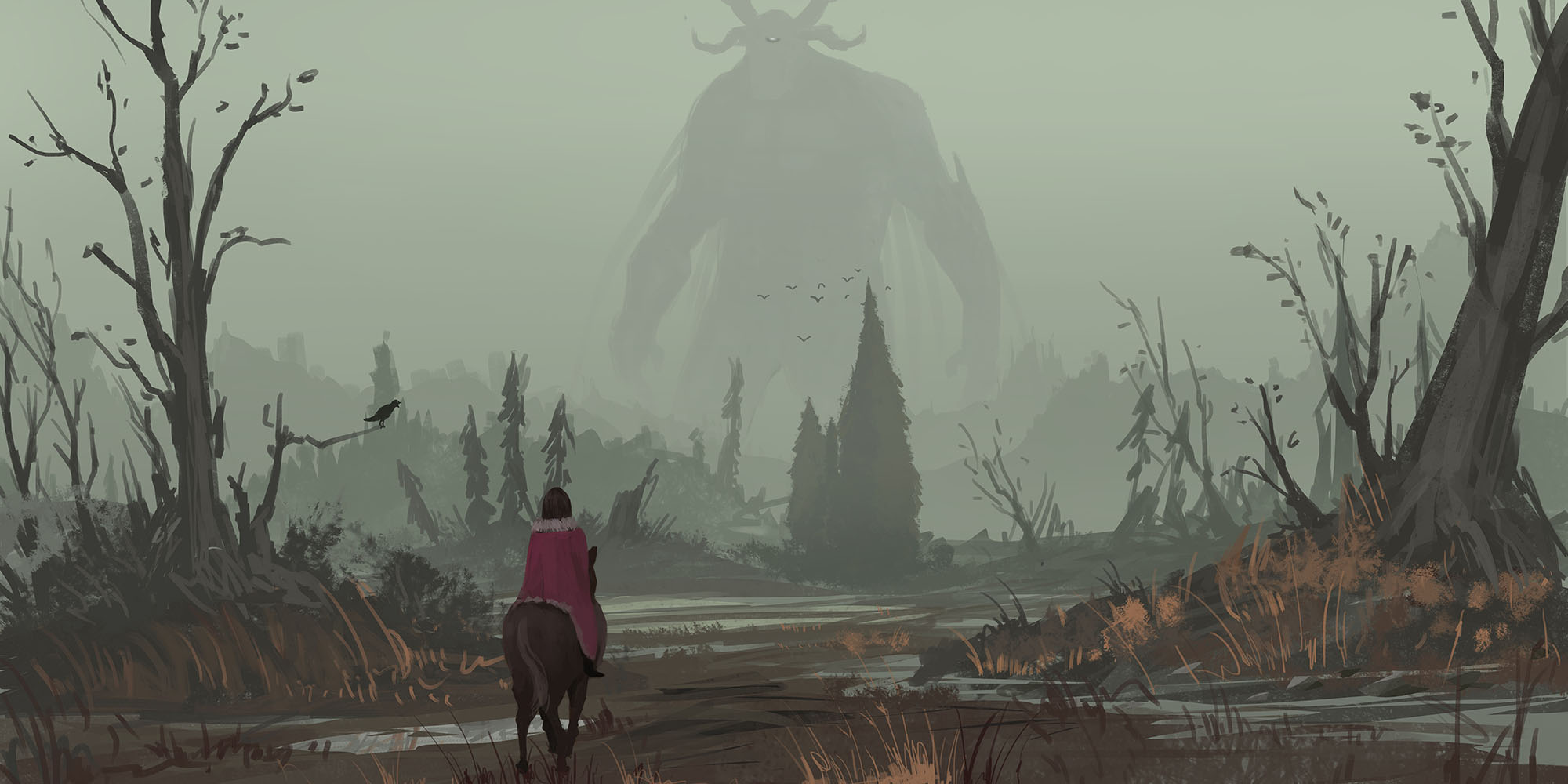You can run a depthcrawl using just the material above, but you may find these advanced options useful. It should be noted, however, that these options are only lightly sketched in. There are quite a few options and variations you could pursue in achieving any of these.
GETTING LOST
If the PCs become lost:
- Add d4-1 depth increments (instead of whatever the normal depth increment is).
- Generate a location at their new depth, which is unconnected to any known location.
Option: If they roll the maximum result on the d4, re-roll using a d6-1. If they roll the maximum result again, step the die result to d8-1. Repeat as necessary.
PCs could become lost by:
- Fleeing a fight
- Getting captured
- Suffering a catastrophe
- Unwilling teleportation
You might also require navigation checks when the PCs are moving between locations. On a failed check, they become lost.
PROGRESS
If the PCs are searching for something specific, you could:
- Randomly determine which location it’s in (and then the PCs can find it when they find that location); or
- Make a random check in each new location to determine if the thing they seek is there (1 in 6, 1 in 10, or whatever feels appropriate).
Alternatively, you could use a system of progress:
- Set a seeking value based on how difficult and/or distant the desired objective is.
- When the group’s progress equals the seeking value, they’ve achieved their goal.
How the group increases their progress will depend on what it is they’re seeking. Options might include:
- exploring a new location
- getting information from an NPC
- reading a relevant tome
- finding a clue
For example, in The Stygian Library, Emmy Allen includes a progress system that can be used to determine when the PCs have successfully found the information they seek within the library.
PCs might also lose progress by:
- being lied to
- becoming lost
- having information or vital artifacts destroyed
What does “progress” actually represent?
One option is that it’s entirely a matter of pacing: There’s just a point where you finally stumble onto the thing you’ve been looking for.
Alternatively, it can represent a breadcrumb trail: A says they think B might know something, but when the PCs get there B is dead (perhaps leaving a documentary clue or maybe you need to hunt down their phantom) or missing (solve their disappearance) or doesn’t know (“…but you know who might?”) or has reportedly gone to location C (“let’s follow them!”).
In practice, it’s likely that the players will provide their own breadcrumb trail by coming up with some clever idea (or not so clever idea) for how they can pursue their goal.
GETTING DIRECTIONS
One weakness of a procedural generation system like a depthcrawl is that it becomes difficult to provide directions. If they’re exploring some unknown land and you run into a friendly native, it would be perfectly natural for the PCs to ask a question like, “Where’s the Ebon Bindery?”
But in a depthcrawl you don’t actually know where the Ebon Bindery is until you’ve randomly generated it, so how can you respond to the perfectly natural question?
Obviously one option is to stonewall: Nobody ever knows where anything is. But this is unsatisfying for any number of reasons (it breaks the suspension of disbelief, it negates meaningful choice, etc.).
Another option is to use progress (see above): Simply say, “The old man gives you directions to the Ebon Bindery,” and set a seeking value. When the PCs follow the directions, they gain progress.
An alternative would be to pregenerate the pointcrawl map between the PCs’ current location and their desired location. You could do that by just randomly rolling until the Ebon Bindery turns up, but it may be more effective to just arbitrarily decide how far away the Ebon Bindery is (or roll 1d6+2 or something like to randomly determine it) and then simply generate the requisite points between here and there. (This is more time consuming, but has the advantage that you can now tell the players what the actual directions are: “You need to head south past the tree bearing Jarcani runes, then turn southeast until you reach the Crimson River…” And so forth.)
REPEATED LOCATIONS
When you re-roll a location that you’ve previously rolled (and placed), what should happen? Broadly speaking, there are two options.
It’s the same location, in which case you draw a path from the PCs’ current location back to the previously visited location. They’ve ended up going in a circle.
It’s a similar, but different location. Roll a new detail and event to customize the new location.
Depending on the situation, you might:
- Always do one or the other. (Note, however, that never having the pointcrawl map loop back on itself will result in a less interesting and perhaps even frustrating map.)
- Arbitrarily choose based on what makes the most sense.
- Randomly determine. (Perhaps roll 1d6; 1-4 means it’s the same location, 5-6 means it’s a new location. Or the other way around.)
Whatever method you use might also vary depending on the type of location. (There’s only one Crystal Grotto in the Forest of Doom, so once you’ve generated it, all future instances are a path back to the same Crystal Grotto. On the other hand, there’s any number of Ancient Trees to be found.)
CHART A COURSE
Let’s say that the PCs want to go back to a known location but NOT by the route they know. (Maybe the way is blocked by goblin cannibals or a volcanic explosion has wiped out the road they took. Whatever.) To accommodate this, you might add a GO AROUND move:
- Make a navigation check. On a failure, treat this as a Go Deeper move instead. (They cannot find their target location.)
- On a success, move the group’s depth one depth increment closer to their target location.
- If their current depth equals their target depth, they’ve found a path to that location.
- If not, make a depth check on the Location table, a depth check on the Details table, and roll for an Event.
- Make an encounter check.
PCs who are lost should not be allowed to Go Around until they have oriented themselves.
RETURNING TO THE DEPTHCRAWL
If the PCs leave the depthcrawl and later return, how should that be handled?
TABULA RASA: In both The Gardens of Ynn and The Stygian Library, Emmy Allen wipes the slate clean. The previously generated map is discarded and you start again from the beginning. These are strange, feyish, and ever-shifting realms, and even your point of entry may not take you to the same place you arrived last time.
PERSISTENT MAP: The other extreme, of course, is to simply not do that. If you leave the Underdark, but then choose to return, the pointcrawl map you’ve generated (and the navigational knowledge the PCs have gleaned) persists.
Of course, if you enter the Underdark or the Venom Abyss from a different location, then it would be perfectly appropriate to begin generating a new pointcrawl map using the same depthcrawl generator. (An interesting question in this case would be whether or not it’s possible to link this new pointcrawl map with the older pointcrawl map. You might take some guidance from “Repeated Locations,” above, but it will also depend on exactly what and where these two entrances are.)
EVER-SHIFTING WAYS: If you want to capture feyish uncertainty or fracturing reality without a complete tabula rasa, you might consider making the paths between locations uncertain. For example, each time the PCs revisit a path there could be a 1 in 6 chance that the path no longer exists, causing them to become either lost or simply stumbling into a different location than the one they expected.
For a truly chaotic landscape, this check might be made every time they revisit a path (even on the same journey). For something subtler, perhaps you check the paths only between expeditions.
CONCLUSION
I’ve mentioned them several times already, but in conclusion I’d like to note that, if you’d like to see what a fully fledged depthcrawl looks like in all its glory, you should check out Emmy Allen’s The Gardens of Ynn and The Stygian Library. They were the first and, as far as I can tell, they remain the best exemplars of the form.














This is really interesting. I’ve just run an intro Over The Edge (1st ed) scenario where they had to get out of the airport. I structured it like a dungeon-crawl but with potential random navigational effects when they used the corridors between locations. Which seemed to have the desired effect in game. But reading these two articles, using this kind of approach for the PCs trying to find the exit might have worked even better.
Holy crap, James. You’re right. I had an Airport adventure for Welcome to the Island that I ended up pulling in part because I couldn’t get the structure right. But it could be done as a depthcrawl.
I briefly ran a module called Castle Gargantua with a similar premise – it was an upward climb rather than a downward descent, but otherwise fits the Depth Crawl concept. The random generation tools produced very evocative results, but the players really did not like the tabula rasa aspect. They felt like they were never making any progress and their exploration decisions didn’t matter, because it all reset when their backs were turned. I think the persistent map is the way to go.
Speaking of which, the Stygian Library dev did another book called Esoteric Enterprises that isn’t quite a depth crawl, but uses a similar node based random generation system to create megadungeons. The mechanics are pretty clunky but the result is a lot of fun for the players to explore – I got way more mileage out of it than I did Castle Gargantua.
There’s a module by another author called Unicorn Meat, which splits the difference with its wilderness system. The results of swamp exploration are drawn randomly, but certain landmarks are persistent once drawn, and can be returned to once discovered. I haven’t run it, so I can’t evaluate how well it works in practice. The concept could easily depth crawl formula, with some locations remaining fixed while the rest of the dungeon is regenerated on repeat visits.
I notice that your “getting lost” depth roll (1d4-1) only allows for staying at the current depth or going deeper whereas a different roll (1d6-3 for example) could allow the players to become lost and go less deep deeper, or stay at the same depth.
Is it simply an artifact of an example you’ve chosen or is it your intent that getting lost generally cannot bring one less deep (and presumably safer)?
Have you read Rowan Rook + Decard’s HEART and if so would you classify the oddnesses of its traversal akin to a depthcrawl or something vastly different?
I think you could use this to model walking through Shadow from the Amber series. Really interesting stuff. I’m a little leery of the need to improvise the actual maps of the locations, though.